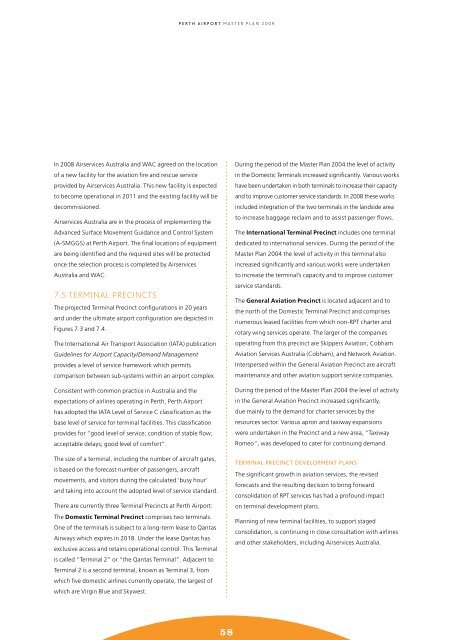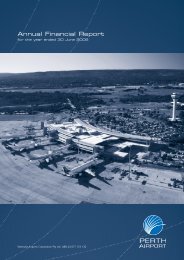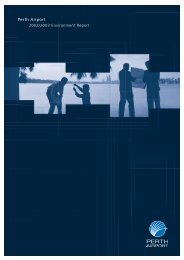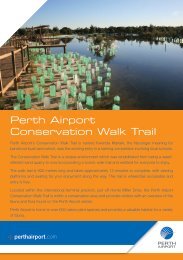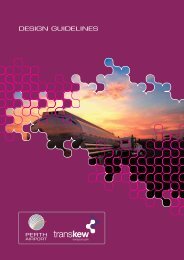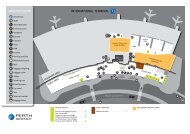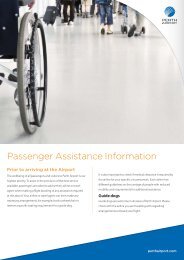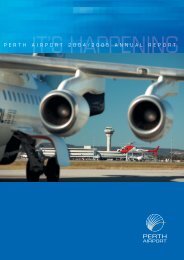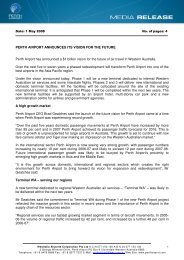PERTH AIRPORT Master Plan 2009
PERTH AIRPORT Master Plan 2009
PERTH AIRPORT Master Plan 2009
Create successful ePaper yourself
Turn your PDF publications into a flip-book with our unique Google optimized e-Paper software.
P E R T H A I R P O R T M a s t e r P l a n 2 0 0 9<br />
In 2008 Airservices Australia and WAC agreed on the location<br />
of a new facility for the aviation fire and rescue service<br />
provided by Airservices Australia. This new facility is expected<br />
to become operational in 2011 and the existing facility will be<br />
decommissioned.<br />
Airservices Australia are in the process of implementing the<br />
Advanced Surface Movement Guidance and Control System<br />
(A-SMGGS) at Perth Airport. The final locations of equipment<br />
are being identified and the required sites will be protected<br />
once the selection process is completed by Airservices<br />
Australia and WAC.<br />
7.5 Terminal Precincts<br />
The projected Terminal Precinct configurations in 20 years<br />
and under the ultimate airport configuration are depicted in<br />
Figures 7.3 and 7.4.<br />
The International Air Transport Association (IATA) publication<br />
Guidelines for Airport Capacity/Demand Management<br />
provides a level of service framework which permits<br />
comparison between sub-systems within an airport complex.<br />
Consistent with common practice in Australia and the<br />
expectations of airlines operating in Perth, Perth Airport<br />
has adopted the IATA Level of Service C classification as the<br />
base level of service for terminal facilities. This classification<br />
provides for “good level of service; condition of stable flow;<br />
acceptable delays; good level of comfort”.<br />
The size of a terminal, including the number of aircraft gates,<br />
is based on the forecast number of passengers, aircraft<br />
movements, and visitors during the calculated ‘busy hour’<br />
and taking into account the adopted level of service standard.<br />
There are currently three Terminal Precincts at Perth Airport:<br />
The Domestic Terminal Precinct comprises two terminals.<br />
One of the terminals is subject to a long-term lease to Qantas<br />
Airways which expires in 2018. Under the lease Qantas has<br />
exclusive access and retains operational control. This Terminal<br />
is called “Terminal 2” or “the Qantas Terminal”. Adjacent to<br />
Terminal 2 is a second terminal, known as Terminal 3, from<br />
which five domestic airlines currently operate, the largest of<br />
which are Virgin Blue and Skywest.<br />
During the period of the <strong>Master</strong> <strong>Plan</strong> 2004 the level of activity<br />
in the Domestic Terminals increased significantly. Various works<br />
have been undertaken in both terminals to increase their capacity<br />
and to improve customer service standards. In 2008 these works<br />
included integration of the two terminals in the landside area<br />
to increase baggage reclaim and to assist passenger flows.<br />
The International Terminal Precinct includes one terminal<br />
dedicated to international services. During the period of the<br />
<strong>Master</strong> <strong>Plan</strong> 2004 the level of activity in this terminal also<br />
increased significantly and various works were undertaken<br />
to increase the terminal’s capacity and to improve customer<br />
service standards.<br />
The General Aviation Precinct is located adjacent and to<br />
the north of the Domestic Terminal Precinct and comprises<br />
numerous leased facilities from which non-RPT charter and<br />
rotary wing services operate. The larger of the companies<br />
operating from this precinct are Skippers Aviation, Cobham<br />
Aviation Services Australia (Cobham), and Network Aviation.<br />
Interspersed within the General Aviation Precinct are aircraft<br />
maintenance and other aviation support service companies.<br />
During the period of the <strong>Master</strong> <strong>Plan</strong> 2004 the level of activity<br />
in the General Aviation Precinct increased significantly,<br />
due mainly to the demand for charter services by the<br />
resources sector. Various apron and taxiway expansions<br />
were undertaken in the Precinct and a new area, “Taxiway<br />
Romeo”, was developed to cater for continuing demand.<br />
Terminal Precinct Development <strong>Plan</strong>s<br />
The significant growth in aviation services, the revised<br />
forecasts and the resulting decision to bring forward<br />
consolidation of RPT services has had a profound impact<br />
on terminal development plans.<br />
<strong>Plan</strong>ning of new terminal facilities, to support staged<br />
consolidation, is continuing in close consultation with airlines<br />
and other stakeholders, including Airservices Australia.<br />
58


